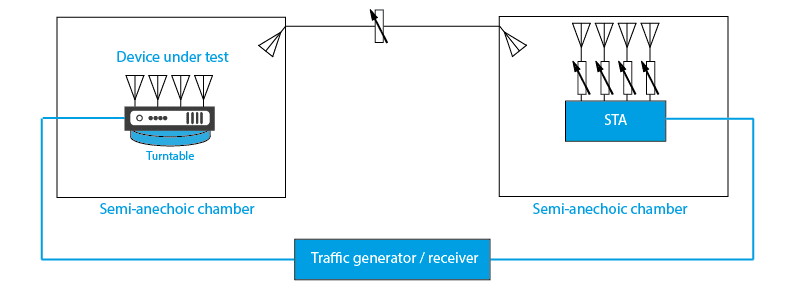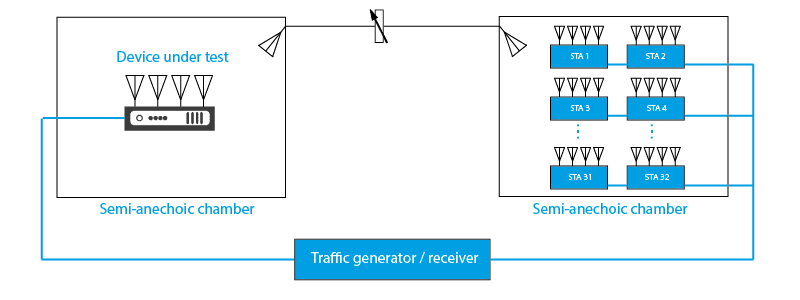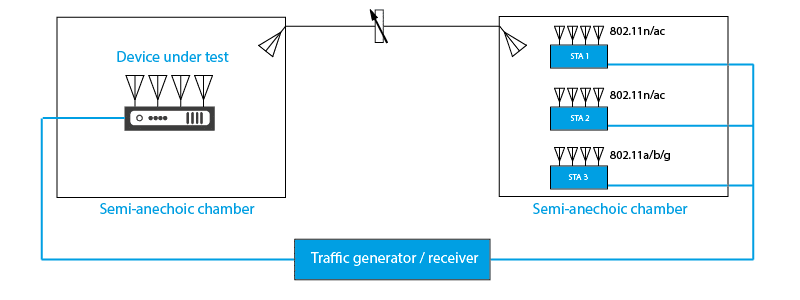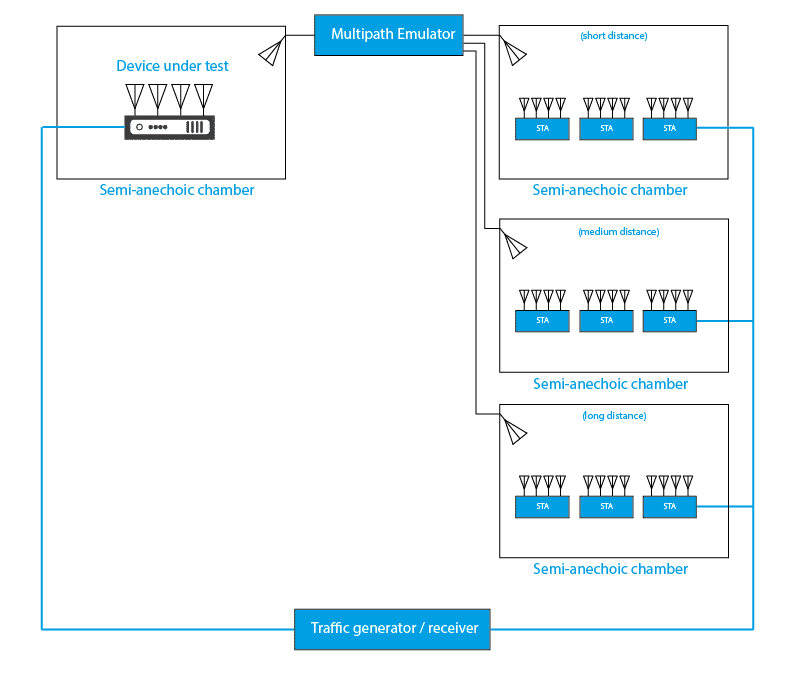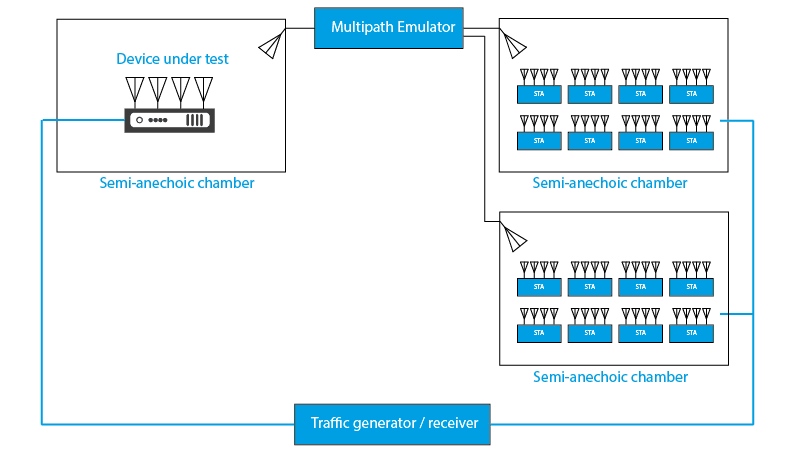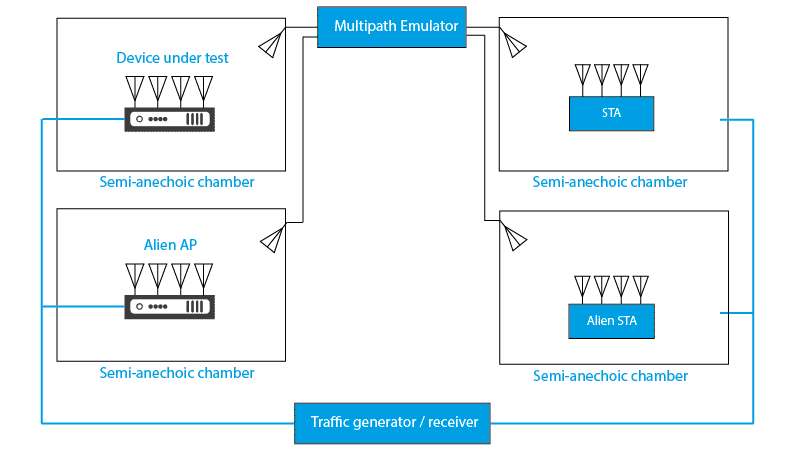Receiver Sensitivity Test.
The receiver sensitivity test requires Ethernet traffic to be generated into the WIFI device under test at 65% of the theoretical maximum speed over the air interface, through a set of RF attenuators into the receiving stations and into a traffic analyser where the traffic is then measured for errors.
This test is performed over a number of iterations, where the attenuation is increased by 1dB in each iteration until there is a 10% error rate on the received signal, at which point the amount of attenuation is measured and recorded as the receiver sensitivity level.
Once the receiver sensitivity measurement has been recorded the whole sequence is repeated again, this time with the WIFI device under test (DUT) having been rotated by 45° within the test chamber. The sequence of testing is repeated until the DUT has been rotated through a full 360°.
Pass / fail criteria: Achieving specified target sensitivity measurements.
Maximum Connections Test.
The test is setup by configuring 32 stations and associating them with the WIFI DUT. RF attenuators are used to setup a 2m fixed distance between the WIFI DUT and every station.
Once all the stations are associated Ethernet test traffic is generated through the DUT and then measured after being received through the stations for 2 minutes.
The test is performed to measure the downlink packet loss and then the downlink packet loss at 2Mbps for 802.11n and 8Mbps for 802.11ac modes.
Pass / fail criteria: Based on the total downlink and uplink speeds achieved.
Maximum Throughput Test.
The maximum throughput utilises a simple test configuration to verify the maximum traffic throughput of the WIFI DUT.
A single station is associated with the DUT with a 2m fixed distance between the DUT and the station. Ethernet traffic is generated in downlink and then uplink directions in both 802.11n and 802.11ac modes with the traffic speed in each direction used as the pass/fail criteria.
Pass / fail criteria: Achieving specified throughput rates.
Airtime Fairness Test.
The airtime fairness test verifies that the WIFI DUT can guarantee the fairness of airtime usage when the availability of the air interface is constrained such as in high throughput or dense connection conditions.
3 stations are utilised in the test, two are 802.11m/ac devices with identical numbers of spatial stream in both 2.4 and 5GHZ bands. The final STA is a legacy 802.11a/b/g device.
Stations 1 and 2 are associated with the DUT and traffic measured for 120 seconds. Station 2 is then moved to a medium distance and the throughput measured again.
Station 2 is then removed and replaced withs station 3 at a short distance. Download speeds in both STA 1 and 3 are measured for 2 minutes.
In the final test station 3 is configured for only 802.11a with a 5GHz operating band and traffic measured for 2 minutes.
Pass / fail criteria: Achieving specified throughput objectives at each of the stations.
Rate vs Range Test
The rate vs range test is performed by using RF attenuation on the station to simulate an increasing distance between a station and the WIFI DUT.
Ethernet traffic is generated through the WIFI DUT to the station and into a traffic analyser for a period of 2 minutes, after which the attenuation is increased and the test repeated.
TCP throughput is measured in the downlink and uplink directions and is used at each iteration of the test as the pass/fail criteria.
Pass / fail criteria: Based on achieved throughputs at specified attenuation levels.
Spatial Consistency Test
The spatial consistency test verifies that the WIFI DUT is able to maintain a consistent signal regardless of the position of the stations in relation to it.
This is accomplished by testing throughput with the stations in different positions in relation to the DUT and with varying levels of attenuation.
The test is performed by generating traffic into the WIFI DUT to a station and into a traffic analyser.
Traffic is measured in the uplink and then downlink directions for 60 seconds, after which the DUT is rotated by 30°, at which point the traffic analysis is performed again. This procedure is repeated until the DUT has been rotated through a full 360° cycle.
The full test sequence is then repeated with different levels of attenuation at the station.
Pass / fail criteria: Based upon the variation in throughput levels observed during the test sequence.
Multiple Stations Performance Test
The test verifies the performance of the DUT in a simulated real-world environment through the analysis of performance when 9 stations are connected to the DUT at differing distances. 3 stations are connected at a short range to the DUT, 3 at a medium range and 3 at a long range.
The 3 short range stations are associated with the DUT and the downlink and uplink speeds to each station are measured over a 2 minute interval.
The 3 medium range stations are then also associated with the DUT and the speeds to each station
measured over a 2 minute interval.
Finally the 3 long range stations are associated with the DUT and the speeds to all 9 stations measured.
Pass / fail criteria: Based on the total throughput measurements of uplink and downlink speeds.
Multiple Association/Disassociation Stability Test
The test verifies the ability of the DUT to maintain a stable throughput whilst stations are associating / disassociating from the WIFI DUT.
8 stations are associated with the DUT and used to measure traffic
throughput through the DUT.
Whilst traffic is being monitored the remaining stations will associate and then disassociate from the DUT then after a 30 second interval re-associate with the DUT again.
The test is performed in both 802.11n and 802.11ac modes.
Pass / fail criteria: Based on the throughput being unaffected by the stations associating and disassociating from the DUT and the error free
Downlink MU-MIMO Performance Test
The test verifies the performance of the DUT when downlink MU-MIMI is enabled. 3 Stations are required for the test, one of which supports 2 spatial streams and 2 supporting only a single spatial stream.
The test is started with the first station associating with the DUT and measuring the downlink TCP throughput for 2 minutes. The STA is the disassociated from the DUT. The sequence is then repeated for STA2 and STA3.
All three stations are the associated and the downlink across all 3 is measured.
The full test sequence is then repeated with DL MU-MIMO disabled.
Pass / fail criteria: The test is passed If the full throughput values with MU-MIMO disabled are at least 45% of the throughput with MU-MIMO enabled AND the sum of the 3 individual station throughput totals with MU-MIMO are greater than without MU-MIMO.
Long Term Stability Test
The stability test verifies the operation of the DUT over a 24 hour test period. During the test two stations will be associated with the DUT and have traffic and PING test performed over them for repeating two minutes intervals.
While the throughput tests are running a 3rd station is used to repetitively associate and then disassociate from the DUT. The association.
Disassociation is performed every 6 minutes during the 24 hour test period.
Pass / fail criteria: Based on a less than 20% deviation from the downlink throughput average over the period of the test and a <0.1% error rate in PING tests.
AP Coexistence Test
The test verifies the performance of the WIFI DUT when a second access point is operating with a connection to a second STA within range of the DUT.
The test is performed by configuring the DUT to have an associated station, Ethernet traffic is transmitted across the air interface between the DUT and that STA.
The second AP and STA are configured with an identical WIFI standard and pre-configured channel settings.
The effect of the second AP on the traffic is observed.
Pass / fail criteria: based upon the variation from the maximum throughput achieved.
